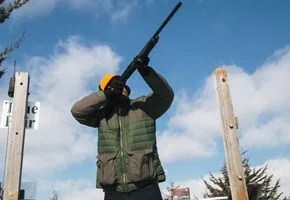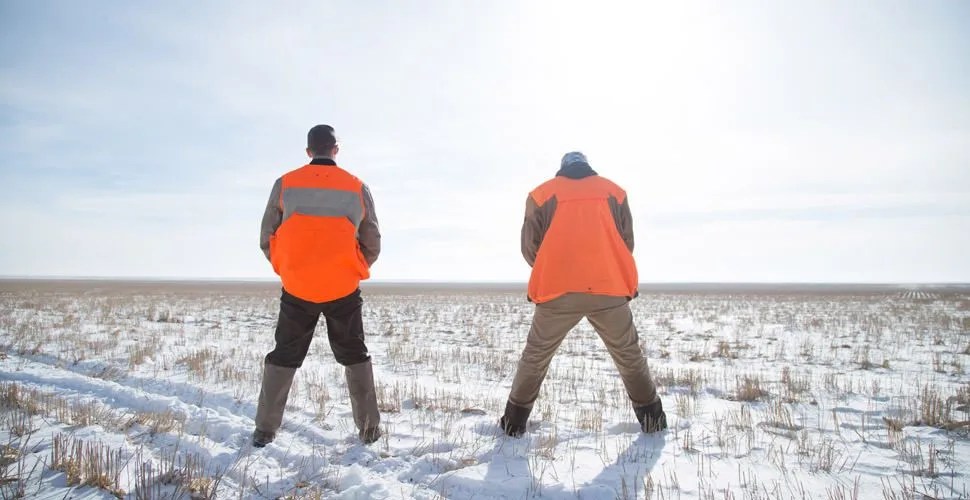In late August, I get an email from the South Dakota Game, Fish and Parks Department. They’ve established a pheasants-per-mile index of 2.68, which registers as a 76 percent increase from the year before. It’s the highest quota in the past decade and a welcome prophecy for a surplus in birds. News like that gets upland hunters oiling shotguns. It got me booking a flight.

The path from San Francisco to Pierre, South Dakota is a long one — in both connotations. But I’ve made the trip many times now, and my heritage here runs deep. My mother grew up in Dixon, near the border of Nebraska and South Dakota. Her father (my grandfather) was a bee farmer, and every year he took to the fields to see if he could shoot down the fowl that flew.
That sportsman pedigree earns a small sliver of credibility for a kid from San Francisco, but it doesn’t thicken my blood. I stand in the frigid cold, waiting at the curb of Eppley Airfield for a college friend. It’s mid-November and the lakes are already frozen. His salt-licked tires round the bend, I hop in the cab and we go warm up with a craft beer at the Crescent Moon.
Sport Shooting

Before heading north, we stop at Oak Creek Sporting Club and grab our shotguns from the backseat. In twelve inches of snow, we migrate through ten different shooting stations on a sporting clay track. It’s a stray Wednesday and no one’s around. I spend my first twenty shells spraying banks of snow, errant shots that miss the mark. Then the instincts and training start to come around, and by the last four stations I’m shattering clays. Sport shooting’s a bit like golf: different stands are like different holes, with different layouts and different launch positions at each location. It’s a separate breed from skeet shooting, and — on a quiet, clear blue day, alone with a friend on the track — it’s an entirely enjoyable way to dust off the rust of prior months spent without a shotgun shouldered.
A hunting trip is rife with rituals. The first is the beer. The next, beginning at dawn, is assembling the gear, checking supplies — jackets, vests, caps, dog collar, shot — and packing the truck. Here in the slow loll of Midwest recreation, process is part and parcel of the experience. We clean out the truck, then load up the bed. Then we head back to the airport to pick up the last two of our party and hit the road pointed north, seven hours between us and Spring Creek Resort — the land around which holds birds by the millions in the miles-long fields of the Pheasant Capital of the World.
South Dakota state law prohibits hunting before 10:00 a.m. Give the birds time for breakfast; give the hunters time to shoot the shit. We congregate with the other hunters in our party, business guys from Omaha, a crew we’ve hunted with in years past. Our numbers total twelve, a little small for the land we’ll hunt, but now, in late November, five weekends after the season opener, it’ll have to do.
On the drive out we see roosters on the roadside, a warm South Dakota welcome. After forty minutes of driving past harvested fields, we pull off the road at the rim of a slough. Outside the truck, the cold seeps through the corners of my clothes, but the wind is low. The plan of attack is drawn on the dirt, heels dragged through the corn field floor. A circle of men huddle, nod heads, then spread out in their roles — walkers, wings, blockers.
20 birds rise, fly low over the reeds, then disappear back down into the growth. Beyond, the burnt orange caps of our comrades sit like tiny boats afloat on a sea of cattails.
It’s quiet, still. The wind is low. Snow layers the field floor. The crops are cleared, but the slough we walk is thick with growth. It snakes through the landscape, the only curves on a farmland grid. The temperature sits at 20 degrees. Gauzy, high clouds cover the sun overhead. There are soft shadows.
Out in the field, we start to hear them — that rooster warble sounding through the brush. We hear them run. We hear them burying themselves in the tangle of cattails, hiding scent. We see their tracks on the snow, the claw marks on deer paths. We sense the escalating panic as the line of hunters moves closer to the end of the field.
The legs and arms and chest are warm. Fingers are not. The gun feels heavy in hand. It’s been a slow walk. Twenty birds rise a hundred yards ahead, fly low over the reeds, then disappear back into the growth. Beyond, the burnt orange caps of our comrades sit like tiny boats afloat on a sea of cattails.
The walkers on the edge round to circle the slough. They’re 50 yards wide, and swing in like a hinge on a gate. Blockers stand in place. We — the four walkers in the middle — keep steady, hold the dogs at bay. Communication comes in hand motions, head nods, whispers. Pheasant are a flighty bunch; the sound of a voice, a dog’s yip, a truck door shut too loud can send them flying.

We move forward in line, breaking reeds under boot, pushing through the growth. The gun is held in front, arms bent and braced. Eyes scan the line, follow the dog, 15 yards out. A rooster rises from the brush. Shots are fired. The bird falls. The dogs get the call — “Bird down!” — and the hustle begins. Pandemonium is more word than fits the occasion, but in a vast expanse that carries only the sound of a light breeze, it feels that big. It’s excitement — an adrenaline rush. The dog retrieves the bird, the neck is rung, the bird placed in jacket, tail-feathers turned up and out, the badge of a successful shot. The gunfire startles the tucked and hidden birds, and they rise from the brush in intermittent waves, panicked and warbling. They’re spotted and tracked in kind — “hens”, the dull-brown females who are granted free passage, and “roosters”, the red ring-necked males with the long tail feathers that we’re here to harvest. More shots are fired. The dogs run through the mix, flushing birds, finding birds, rooting through the brush. This is the slough harvest, one of the finest hunts we’ll see. Not every shot fells a bird. Not every bird goes down clean. Not every hunt measures up, but this year, the slough is particularly good.
We dig nails into feathers and tear back skin at the breast bone. Then we dive in a knife and carve the still-warm breast meat from the bone.
At day’s close, the temperatures drop with the sun, and by the time we’re back at the lodge, it’s dark out with temps in the low teens. We huddle around the truck to clean birds. We dig nails into feathers and tear back skin at the breast bone. Then we dive in a knife and carve the still-warm breast meat from the bone. We bag the breasts and pass them along to the chef. An hour later, we’re seated around a long table, now showered and presentable, when the food arrives. It’s hearty, good food: pheasant and wild rice soup, pheasant kabobs, and pheasant “poppers”: pheasant mixed with jalapeño and cheese, all wrapped in bacon. We fuel up and stay long in respite from the cold. Tomorrow and the next day, the ritual repeats.
Three days of hunting turns up good harvest, though each year always brings alive the tall tales of years past. Talk turns to five years, ten years back, and when the old guys begin to get gauzy-eyed, the young ones flip talk to next year, where it’s proclaimed, right here and now, that there will be more than enough birds to bring everyone back. We shake hands, exchange salutations, then the four of us get in the truck and drive the seven hours down to Nebraska, to the high-rises of Omaha, the connectedness of an international airport. We drop off two friends at Eppley, but I stay back, one day longer, to complete the final ritual of the hunt. Hunting is process. I’m here to see it through.
That last night my college friend and I unpack the truck, and as clothes get cleaned in the wash, we hunker down in the basement with two lights, a sturdy table, a bag full of rags, gun wash and a bottle of oil. We pull the shotguns from their cases, and take them apart, disassembling them down to their core components, taking Q-Tips and small pieces of cloth to clean out their inner chambers. We sit side by side, recounting the hunts, the hits and misses, the cold, the pheasant soup, the gravel roads and the way the horizon up there never seems to end. The guns are oiled, the pin finds its place, and the action is tested. We leave them clean and like new, locked in the safe in the basement, and return upstairs for one last meal. Sitting around the table, this time sharing a basic marinara with pasta, we tell final stories, talk of plans to get out more than once next year. Everything’s returned to order. The guns are packed, the clothes in the wash, the dog sleeps at our feet. Everything’s back to rights, everything as it was — save for the handful of birds that bravely flew and unluckily fell out in the unforgiving and wide-open South Dakotan plains.
